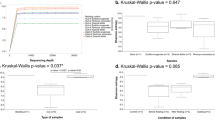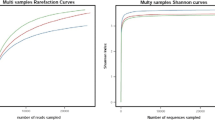Abstract
The cultured aerobic copiotrophic bacteria and fungi from food-free digestive tracts of Aporrectodea caliginosa, Lumbricus terrestris, and Eisenia fetida earthworms, soil (compost), and fresh earthworm excrements were investigated. The microorganisms were isolated on nutrient media and identified by sequencing the fragments of bacterial 16S rRNA and fungal 28S rRNA (D1/D2 domain) gene sequences with subsequent phylogenetic analysis. Bacteria isolated from the digestive tracts of earthworms belonged to the families Aeromonadaceae, Comamonadaceae, Enterobacteriaceae, Flavobacteriaceae, Moraxellaceae, Pseudomonadaceae, and Sphingobacteriaceae (Bacteroidetes), as well as Actinobacteria. For five strains, namely Ochrobactrum sp. 341-2 (α-Proteobacteria), Massilia sp. 557-1 (β-Proteobacteria), Sphingobacterium sp. 611-2 (Bacteroidetes), Leifsonia sp. 555-1, and a bacterium from the family Microbacteriaceae, isolate 521-1 (Actinobacteria), the similarity to known 16S rRNA sequences was 93–97%; they therefore, probably belong to new species and genera. Bacterial groups isolated from the digestive tracts of earthworms were significantly different from those isolated from soil and excrements. Some bacterial taxa occurred in different sections of A. caliginosa intestine and in intestines of different earthworm species; however, the overall composition of bacterial communities in these objects is different. Existence of bacterial groupings symbiotically associated with intestines is proposed. Among the fungi, Bjerkandera adusta and Syspastospora parasitica were isolated from the cleaned digestive tracts as light-colored, sterile mycelium, as well as Geotrichum candidum, Acremonium murorum (A. murorum var. felina), Alternaria alternata, Aspergillus candidus, A. versicolor, Cladosporium cladosporioides, Rhizomucor racemosus, Mucor hiemalis, Fusarium (F. oxysporum, Fusarium sp.), and Penicillium spp. These fungi survive for a long time in the earthworm’s digestive environment. Investigation of the functional characteristics and role in the host organism is required to confirm the symbiotic status of the microorganisms associated with the earthworm digestive tract.
Similar content being viewed by others
References
König, H. and Varma, A., Intestinal Microorganisms of Termites and Other Invertebrates, in Soil Biol., Ser. Edit., Köning, H. and Varma, A., Eds., Berlin-Heidelberg: Springer-Verlag, 2006, vol. 6.
Byzov, B.A., Zoomicrobial Interactions in Soil, Extended Abstract of Doctoral (Biol. Dissertation, Moscow: Maks Press, 2003.
Bignell, D.E., Oskarsson, H., and Anderson, J.M., Colonization of the Epithelial Phase of the Peritrophic Membrane and the Ectoperitrophic Space by Actinomycetes in a Soil-Feeding Termite, J. Invertebr. Pathol., 1980, vol. 36, no. 3, pp. 426–428.
Griffiths, B.S. and Wood, S., Microorganisms Associated with the Hindgut of Oniscus asellus (Crustacea, Isopoda), Pedobiologia, 1985, vol. 28, pp. 377–381.
Jolly, J.M., Lappin Scott, H.M., Anderson, J.M., and Clegg, C.D., Scanning Electron Microscopy of the Gut Microflora of Two Earthworms: Lumbricus terrestris and Octolasion cyaneum, Microbial Ecol., 1993, vol. 26, pp. 235–245.
Mendez, R., Borges, S., and Betancourt, C., A Microscopical View of the Intestine of Onychochaeta borincana (Oligochaeta: Glossoscolecidae), Pedobiologia, 2003, vol. 47, nos. 5–6, pp. 900–903.
Gusteleva, L.A. and Isaev, A.S., Mikroflora nasekomykhksilofagov (Microflora of Xylophage Insects), Novosibirsk: Nauka, Sibirskoe otdelenie, 1982.
Shivokene, Ya.S. and Malukas, E.Z., Symbiotic Microflora of the Insect Digestive Tract and Its Role in Pathogenesis, Trudy AN Lit. SSR, 1984, no. 4, pp. 98–110.
Tret’yakova, E.B., Dobrovol’skaya, T.G., Byzov, B.A., and Zvyagintsev, D.G., Bacterial Communities Associated with Soil Invertebrates, Mikrobiologiya, 1996, vol. 65, no. 1, pp. 102–110 [Microbiology (Engl. Transl., vol. 65, no. 1, pp. 91–97].
Ineson, P. and Anderson, J.M., Aerobically Isolated Bacteria Associated with the Gut and Faeces of the Litter Feeding Macroarthropods Oniscus assellus and Glomeris marginata, Soil Biol. Biochem., 1985, vol. 17, pp. 843–849.
Szabó, I.M., Chu, T.L., Contreras, E., Heydrich, M., Jáger, K., Marialigeti, K., Pobozsny, M., Ravasz, K., and Zicsi, A., On the Problems of Intestinal Bacteriology of Forest-Litter Consuming Invertebrates, in Soil Fauna and Soil Fertility, Proc. 9th Int. Colloquium on Soil Zoology Striganova, B.R., Ed., Moscow: Nauka, 1987, pp. 58–63.
Byzov, B.A., Chernjakovskaya, T.F., Zenova, G.M., and Dobrovolskaya, T.G., Bacterial Communities Associated with Soil Diplopods, Pedobiologia, 1996, vol. 40, pp. 67–79.
Sampedro, L. and Whalen, J.K., Changes in the Fatty Acid Profiles Through the Digestive Tract of the Earthworm Lumbricus terrestris L., Appl. Soil Ecol., 2007, vol. 35, no. 1, pp. 226–236.
Karsten, G.R. and Drake, H.L., Denitrifying Bacteria in the Earthworm Gastrointestinal Tract and in vivo Emission of Nitrous Oxide (N2O) by Earthworms, Appl. Environ. Microbiol., 1997, vol. 63, pp. 1878–1882.
Matthies, C., Griesshammer, A., Schmittroth, M., and Drake, H.L., Evidence for Involvement of Gut-Associated Denitrifying Bacteria in Emission of Nitrous Oxide (N2O) by Earthworms Obtained from Garden and Forest Soils, Appl. Environ. Microbiol., 1999, vol. 65, pp. 3599–3604.
Ihssen, J., Horn, M.A., Matthies, C., Göβner, A., Schramm, A., and Drake, H.L., N2O-Producing Microorganisms in the Gut of the Earthworm Aporrectodea caliginosa Are Indicative of Ingested Soil Bacteria, Appl. Environ. Microbiol., 2003, vol. 69, pp. 1655–1661.
Horn, M.A., Schramm, A., and Drake, H.L., The Earthworm Gut: an Ideal Habitat for Ingested N2O-Producing Microorganisms, Appl. Environ. Microbiol., 2003, vol. 69, pp. 1662–1669.
Horn, M.A., Mertel, R., Gehre, M., Kastner, M., and Drake, H.L., In Vivo Emission of Dinitrogen by Earthworms via Denitrifying Bacteria in the Gut, Appl. Environ. Microbiol., 2006, vol. 72, no. 2, pp. 1013–1018.
Héry, M., Singer, A.C., Kumaresan, D., Bodrossy, L., Stalis-Pavese, N., Prosser, J., Thompson, I.P., and Murrel, J.C., Effect of Earthworms on the Community Structure of Active Methanotrophic Bacteria in a Landfill Soil, Int. Sci. Microbial. Ecolog. J., 2008, vol. 2, pp. 92–104.
Jones, C.G., Lawton, J.H., and Shachak, M., Positive and Negative Effects of Organisms as Physical Ecosystem Engineers, Ecology, 1997, vol. 78, pp. 1946–1957.
Sambrook, J. and Russel, D.W., Molecular Cloning: A Laboratory Manual. 3rd Ed, New York: Gold Spring Harbor Laboratory Press, 2001.
Altschul, S.F., Madden, T.L., Schäffer, A.A., Zhang, J., Zhang, Z., Miller, W., and Lipman, D.J., Gapped BLAST and PSI-BLAST: a New Generation of Protein Database Search Programs, Nucleic Acids Res., 1997, vol. 5, pp. 3389–3402.
Tamura, K., Dudley, J., Nei, M., and Kumar, S., MEGA4: Molecular Evolutionary Genetics Analysis (MEGA) Software Version 4.0, Mol. Biol. Evolut., 2007, pp. 1596–1599.
Khomyakov, N.V, Kharin, S.A., Nechitailo, T.Yu., Golyshin, P.N., Kurakov, A.V., Byzov, B.A., and Zvyagintsev, D.G., Reaction of Microorganisms to the Digestive Fluid of Earthworms, Mikrobiologiya, 2007, vol. 76, no. 1, pp. 45–54 [Microbiology (Engl. Transl., vol. 76, no. 1, pp. 45–54].
Byzov, B.A., Khomyakov, N.V., Kharin, S.A., and Kurakov, A.V., Fate of Soil Bacteria and Fungi in the Gut of Earthworms, Eur. J. Soil Biol., 2007, vol. 43, pp. 149–156.
Karsten, G.R. and Drake, H.L., Comparative Assessment of the Aerobic and Anaerobic Microfloras of Earthworms’ Guts and Forest Soils, Appl. Environ. Microbiol., 1995, vol. 61, no. 3, pp. 1039–1044.
Marialigeti, K., On the Community Structure of the Gut-Microbiota of Eisenia lucens (Annelida, Oligochaeta), Pedobiologia, 1979, vol. 19, pp. 213–220.
Contreras, E., Studies on the Intestinal Actinomycete Flora of Eisenia lucens (Annelida, Oligochaeta), Pedobiologia, 1980, vol. 20, pp. 411–416.
Ravasz, K., Zicsi, A., Contreras, E., Szell, V., and Szabo, I.M., The Intestinal Actinomycete Flora of Some Earthworm Species, Opusc. Zool., 1986, vol. 22, pp. 85–102.
Shaw, C. and Pawluk, S., Faecal Microbiology of Octalasion tyrtaeum, Apporrectodea turgida and Lumbricus terrestris and Its Relation to the Carbon Budgets of Three Artificial Soils, Pedobiologia, 1986, vol. 29, no. 6, pp. 377–389.
Dkhar, M.S. and Mishra, R.R., Microflora in the Gut Contents of the Earthworm (Amynthas diffringens Baird.), J. Phytol. Res., 1991, vol. 4, pp. 155–159.
Toyoto, K. and Kimura, M., Microbial Community Indigenous to the Earthworm Eisenia foetida, Biol. Fertil. Soils, 2000, vol. 31, nos. 3/4, pp. 187–190.
Moody, S.A., Piearce, T.G., and Dighton, J., Fate of Some Fungal Spores Associated with Wheat Straw Decomposition on Passage Through the Guts of Lumbricus terrestris and Aporrectodea longa, Soil Biol. Biochem., 1996, vol. 28, pp. 533–537.
Nguyen Dyk, T.L., Byzov, B.A., Zenova, G.M., and Zvyagintsev, D.G., Antagonistic Properties of Actinomycetes Associated with the Digestive Tract of Soil Invertebrates, Vest. Mosk. Un-ta, Ser. 17, Soil Sci., 1966, no. 3, pp. 70–77.
Author information
Authors and Affiliations
Corresponding author
Additional information
Original Russian Text © B.A. Byzov, T.Yu. Nechitaylo, B.K. Bumazhkin, A.V. Kurakov, P.N. Golyshin, D.G. Zvyagintsev, 2009, published in Mikrobiologiya, 2009, Vol. 78, No. 3, pp. 404–413.
Rights and permissions
About this article
Cite this article
Byzov, B.A., Nechitaylo, T.Y., Bumazhkin, B.K. et al. Culturable microorganisms from the earthworm digestive tract. Microbiology 78, 360–368 (2009). https://doi.org/10.1134/S0026261709030151
Received:
Published:
Issue Date:
DOI: https://doi.org/10.1134/S0026261709030151




